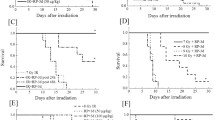Abstract.
When people are exposed to large doses of ionizing rays in a short time, hematopoiesis is impaired and hemorrhage is one of the major clinical features. Suddenly decreasing platelet counts are responsible for the life-threatening hemorrhagic complication. Therefore, some cytokines have been used to improve thrombocytopoiesis in various radiation-induced thrombocytopenia models. Current measures for this purpose involve repeated intravenous or subcutaneous injections of recombinant proteins, which are expensive and inconvenient, or gene therapy with viral vectors that could not obviate the risk of infection. We tried to determine the possibility of gene therapy with plasmid vectors for radiation-induced hematopoietic injury, which could overcome the above-mentioned problem. In this study, we describe the enhanced efficiency of radiation on gene transfer with plasmid vector in vivo and the physiological role of expressed human interleukin-6 (hIL-6) in vivo on a radiation-induced thrombocytopenia model. After a single intramuscular injection of plasmid hIL-6 DNA on 6.5-Gy-irradiated mice, the hIL-6 protein level in mouse plasma was determined with enzyme-linked immunosorbent assay (ELISA). The level of hIL-6 began to increase from the 4th day, reached the peak value on about the 11th day, and remained at a higher level on the 28th day. Meanwhile, unirradiated mice injected with the same amount of plasmid DNA showed less hIL-6 on the 11th day after administration. Further experiments demonstrated that the hIL-6 level in 7.5-Gy-irradiated mice was about three times higher than that of 5.0-Gy-irradiated mice, suggesting radiation could improve gene transfer efficiency of plasmid DNA in vivo and might be dependent on radiation doses. The expression of hIL-6 in vivo showed a significant effect on hematopoietic recovery after radiation. Not only the platelet nadir in peripheral blood, but also the number of colony-forming cells in bone marrow rose. The increased platelet counts were partially due to the increase of reticulated platelet that reflected the activity of a given population of megakaryocyte in bone marrow. We conclude that radiation could significantly enhance the gene transfer efficiency of plasmid DNA and that gene therapy with plasmid vectors for radiation-induced hematopoietic injury might be more effective than other diseases without DNA repair.
Similar content being viewed by others
Author information
Authors and Affiliations
Additional information
Electronic Publication
Rights and permissions
About this article
Cite this article
Sun, .L., Liu, .X., Qiu, .L. et al. Administration of plasmid DNA expressing human interleukin-6 significantly improves thrombocytopoiesis in irradiated mice. Ann Hematol 80, 567–572 (2001). https://doi.org/10.1007/s002770100345
Received:
Accepted:
Issue Date:
DOI: https://doi.org/10.1007/s002770100345




